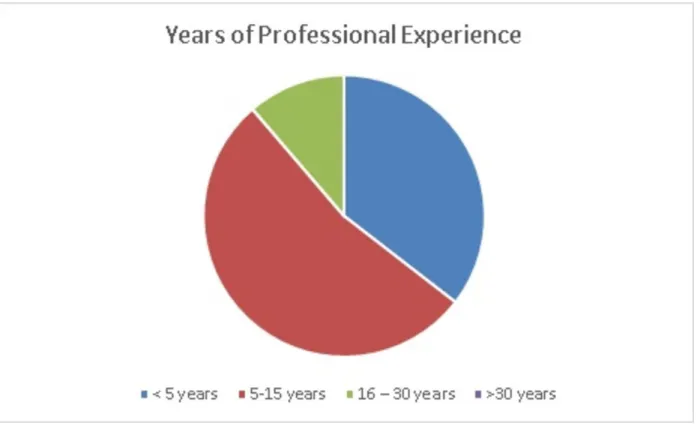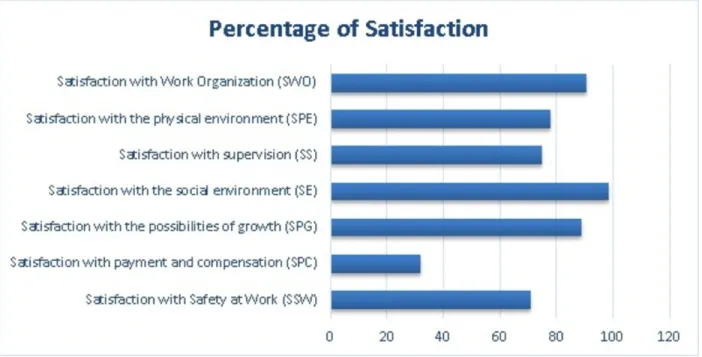Job satisfaction of radiographers
Poster No.: C-1635
Congress: ECR 2019
Type: Scientific Exhibit Authors: S. Souto1
, A. F. Abrantes1, C. A. Silva2, L. P. V. Ribeiro3, R. P. P. Almeida4, K. B. Azevedo5, O. Lesyuk6; 1Faro/PT, 2Évora/PT,
3
Parchal/PT, 4Faro /PT, 5Faro, EU/PT, 6São Brás de Alportel/PT Keywords: Workforce, Quality assurance, Education and training,
Physiological studies, Health policy and practice, Audit and standards, MR, Digital radiography, CT, Radiographers, Professional issues, Management
DOI: 10.26044/ecr2019/C-1635
Any information contained in this pdf file is automatically generated from digital material submitted to EPOS by third parties in the form of scientific presentations. References to any names, marks, products, or services of third parties or hypertext links to third-party sites or information are provided solely as a convenience to you and do not in any way constitute or imply ECR's endorsement, sponsorship or recommendation of the third party, information, product or service. ECR is not responsible for the content of these pages and does not make any representations regarding the content or accuracy of material in this file.
As per copyright regulations, any unauthorised use of the material or parts thereof as well as commercial reproduction or multiple distribution by any traditional or electronically
Aims and objectives
The purpose of this research was to evaluate the professional satisfaction of radiographers using the basic task dimensions tool developed primarily by Hackman e Oldham.
The specific objectives were:
• To understand the realtion between the several work content variables and the satisfaction with the job;
• To understand the relation between the several work context variables and the satisfaction with the job;
• Try to identify other factors related to the job satisfaction;
• Try to relate the socio-demographic data from radiographers to the job satisfaction.
Methods and materials
The dependent variable was the job satisfaction;
The independent variables were:
(1) Work content dimensions • Variety of skills (VS); • Identity (I);
• Task Meaning (TM); • Autonomy (A);
• Intrinsic feedback (IF); • Extrinsic feedback (EF); • interrelationship (IR). (2) Work context dimensions
• Satisfaction with the social environment (SE); • Satisfaction with supervision (SS);
• Satisfaction with the possibilities of growth (SPG); • Satisfaction with the physical environment (SPE); • Satisfaction with payment and compensation (SPC); • Satisfaction with Work Organization (SWO);
• Satisfaction with Safety at Work (SSW). The survey was composed by:
• One section with 17 items, to access the work context; • One section with 20 items, to access the work content;
• One section to access directly the satisfaction and insatisfaction; • A sociodemographic characterization.
The survey was paper-based and was applied directly to the radiographers that wished to participate.
Results
The sample was composed by 72 radiographers, selected by convenience, working in the public sector of the Algarve region.
Most of the participants work for 5 to 15 years Fig. 1 on page 5.
The internal reliability of the survey was 0.881, assessed by the Cronbach's alpha.
There were no significant correlations between the sociodemographic data collected and the several dimensions of job satisfaction, accessed with the Kruskal-Wallis test.
The percentage of satisfaction related to work content dimensions (Fig. 2 on page 5) were:
• Variety of skills (VS) = 90,5% • Identity (I) = 100%
• Task Meaning (TM) = 100% • Autonomy (A) = 93,7%
• Intrinsic feedback (IF) = 100% • Extrinsic feedback (EF) = 59% • Interrelationship (IR) = 61,9%
The percentage of satisfaction related to work context dimensions (Fig. 3 on page 6 were:
• Satisfaction with the social environment (SE) = 98,4% • Satisfaction with supervision (SS) = 74,6%
• Satisfaction with the possibilities of growth (SPG) = 88,7% • Satisfaction with the physical environment (SPE) = 77,8% • Satisfaction with payment and compensation (SPC) = 31,7% • Satisfaction with Work Organization (SWO) = 90,5%
Images for this section:
Fig. 1: Professional Experience (years)
Fig. 2: Satisfaction related to Task Content Dimensions (%)
© Medical Imaging and Radiotherapy Department - University of Algarve
Fig. 3: Satisfaction related to Task Context Dimension (%)
Conclusion
This tool provides management with the satisfaction levels at different domains, which may allow to work on those areas.
Several areas shown to be at the minimal satifaction level, which indicates the need to improve the weak areas.
In a global approach, the work context has the lowest satifaction scores.
In general, it is possible to say that radiographers are professionally satisfied. However, it is of major importance to show to the managers that human resources policies and management related problems still need major attention and improvement.
In order to further strengthen and validate the findings of the study, interviews can be carried out.
Personal information
Susana Souto (BSc), Collaborator in the Medical Imaging and Radiotherapy Department, Health School - University of Algarve, Portugal.
António Abrantes (PhD), Professor in the Medical Imaging and Radiotherapy Department, Health School - University of Algarve, Portugal. Researcher in CICS.NOVA.UÉvora (Interdisciplinary Centre of Social Sciences - Évora Centre) and Member of Studies Center in Healthcare (CES-ESSUALG). E-mail: aabrantes@ualg.pt
Carlos Alberto da Silva (PhD), Professor with aggregation in the Sociology Department - University of Évora, Portugal. Researcher in CICS.NOVA.UÉvora (Interdisciplinary Centre of Social Sciences - Évora Centre). E-mail: casilva@uevora.pt
Luís Ribeiro (PhD), Professor in the Medical Imaging and Radiotherapy Department, Health School - University of Algarve, Portugal. Researcher in CIDAF - University of Coimbra (Centro de Investigação do Desporto e da Atividade Física) and Member of Studies Center in Healthcare (CES-ESSUALG). Email: lpribeiro@ualg.pt
Rui Almeida (MSc), Professor in the Medical Imaging and Radiotherapy Department, Health School - University of Algarve, Portugal. Radiographer in Centro Hospitalar Universitário do Algarve - Faro, Portugal. Researcher in CICS.NOVA.UÉvora (Interdisciplinary Centre of Social Sciences - Évora Centre) and Member of the Studies Center in Healthcare (CES-ESSUALG). E- mail: rpalmeida@ualg.pt
Kevin Azevedo (PhD), Professor in the Medical Imaging and Radiotherapy Department, Health School - University of Algarve, Portugal. Radiographer in Centro Hospitalar Universitário do Algarve - Faro, Portugal. Researcher in CICS.NOVA.UÉvora (Interdisciplinary Centre of Social Sciences - Évora Centre) and Member of the Studies Center in Healthcare (CES-ESSUALG). E-mail: kbazevedo@ualg.pt
Images for this section:
Fig. 4
References
Fortin, M. F. (2003). O Processo de Investigação: Da concepção à realização. Lisboa: Edições Técnicas e Científicas, Lda
Goulart, I. B. (2002). Psicologia organizacional e do Trabalho: teoria, pesquisa e temas correlatos. São Paulo: Casa do Psicólogo
Hackman, J. R. & Oldham, G. R. (1975). Development of job diagnostic survey. Journal of Applied Psychology, 60 (2), 159-170
Hakman, R. J. & LawlerI, E. E. (1971). Employee reactions to job characteristics. Journal of Applied Psychology, 55 (3), 259-286
Martinez, M. C., Paraguay, A.I. & Latorre, M.R. (2004). Relação entre satisfação com aspectos psicossociais e saúde dos trabalhadores. Revista de Saúde Pública, 38, 55-61
Robbins, S. (2002). Comportamiento Organizacional. (8ª ed.). México: Editora Pearson Prentice-Hall
Steijn, B. (2004). Human Resource Management and Job Satisfaction in the Dutch Public Sector. Review of Public Personnel Administration, Thousand Oaks, v. 24, nº 4, 291-303

